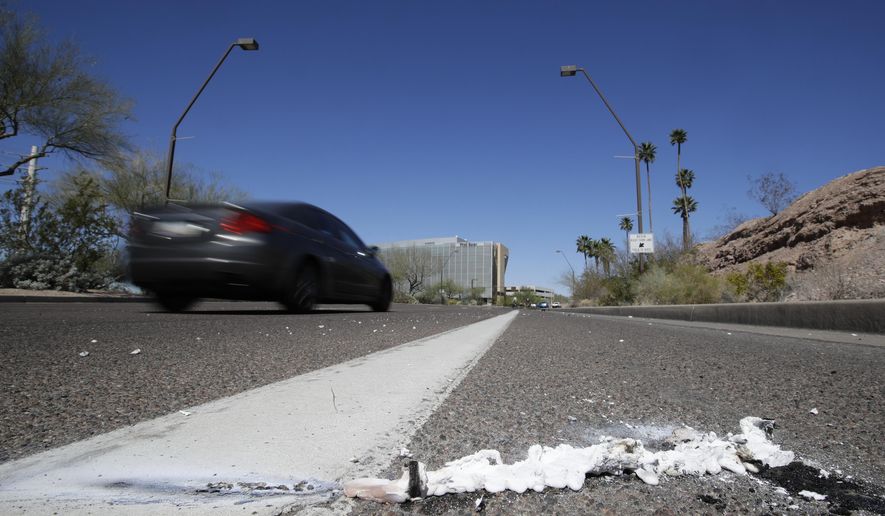OPINION:
In January, Nasdaq sang with the happy tune that Nvidia, traded as NVDA, hit a new 52-week high for its stock price, a direct result of its technology presentation at the global CES conference — a presentation that included its latest in driverless car innovation.
Ahh, a clue. At long last, a whiff of why the recent spate of wrecks tied to self-driving vehicles hasn’t resulted in a complete shuttering of company investment in this technology. Simply put, there’s massive money-making going on.
And apparently, the potential windfall is enough to blot out the scary headlines of artificial intelligence run amok.
There was this, from the New York Times in March: “How a Self-Driving Uber Killed a Pedestrian in Arizona.”
Then this, from the BBC, also in March: “Tesla in fatal California crash was on Autopilot.”
Then this, from the Guardian in May: “Tesla that crashed into police car was in ’autopilot’ mode, California official says.”
Calling Ralph Nader. It seems the world of autonomous vehicles could use a good infusion of consumer protectionism right about now, yes?
But here’s the thing: With self-driving vehicle technology, big bucks are on the line. And in the words of at least one mechanical engineering expert, the rush to produce — the rush to profit — is both real and dangerous.
“Yes, the companies are rushing and [they] need the focus more on testing,” said Mary “Missy” Cummings, professor in the Department of Mechanical Engineering and Materials Science at Duke University, in an email.
She’s written extensively on the matter, in one paper calling for tougher licensing and certification requirements for autonomous car makers — in another, for better technology, more transparency and a concerted reach-out to draw more students to study the field in college.
“[M]anufacturers are failing to address many problems that are known,” Cummings wrote in her April 2017 paper, “The Brave New World of Driverless Cars,” in reference to a Florida Tesla-tied fatality that saw the driver, operating in Autopilot, plow at 74 miles per hour into the back of a tractor trailer that had slowed to take a turn.
“Tesla knew [then] about the inability of Autopilot to detect static objects on highways,” Cummings went on.
But rather than fix or perfect this technology, Tesla instead included in its driver manuals a brief mention that Autopilot is not, as commonly believed, a mode for autonomous driving, but rather one for “driver assist.” Who knew?
Certainly not that driver in the Florida crash. But probably not many who follow the advancement of driverless car technology solely from the perspective of a layperson and consumer — from the arena of one simply watching and waiting for next cool gadget of convenience, and of the mindset that Big Government simply wouldn’t let anything into the market that hadn’t been fully vetted and deemed safe.
Except with self-driving cars, that’s exactly what’s happening. And to circle back to Nasdaq and its rocking write-up of Nvidia — therein lies a clue as to why.
In late 2017, the Brookings Institution reported that the total investment in artificially intelligent-driven vehicles for the United States, China, Germany, Israel and the United Kingdom stood at $80 billion, spread over the course of 160 separate deals forged between August 2014 and June 2017.
That mountain of money has spurred a massive race to the finish line in AI driving, pitting technology companies against car manufacturers and even auto suppliers like Bosch. The competition’s fierce — but then came the startups, ratcheting race frenzy further. From MIT came Nutonomy, with a $20 million investment; out of Ford grew ArgoAI, tossing out a cool $1 billion.
Brookings reported that by 2017 roughly 263 startups had jumped into the autonomy vehicles’ game. And that was just the beginning.
“Meet Aurora Innovation, the Ambitious Self-Driving Car Startup,” Fortune wrote, in a January 2018 headline.
And this, from Business Insider that same month: “Self-driving car startup Pony.ai raises over $100 million.”
All that — and most Americans still say they’re scared of self-driving vehicles. In a recent Axios/Survey Monkey poll, fully 68 percent of participants said they’d fear walking around cars propelled by artificial intelligence, and another 64 percent said they’d be too frightened to sit in the self-driven vehicle as a passenger. Only 10 percent said they’d feel extremely or very safe either in or around an autonomously driven vehicle.
Yet the market’s still booming; the money’s still churning. And every now and again, news headlines are still sounding the drum with the latest of an autonomous vehicle-tied crash, injury or death.
It’s well and good autonomous vehicle makers want to provide a service for the community that could help, say, the blind and handicapped regain travel independence, or assist the harried executive who needs to work while commuting. But one has to wonder: Who are they really interested in helping most? The citizenry, or themselves?
If the scale is money versus consumer safety and preference, the balance so far is weighted heavily on the side of cash and profit.
Perfecting safety features before rushing to market may prove a tough sell to money-driven and publicly traded tech and manufacturing companies. But in the end, it’s the safe car the consumers will pick. And they’ll make that pick in a language the free market can easily understand — dollars and cents. The real winner of this autonomous car race will be the one who forgoes the short-term IPOs for the longer-term of consumer confidence.
The real winner will be the one who puts safety and concern for citizens above cold hard cash.
• Cheryl Chumley can be reached at cchumley@washingtontimes.com or on Twitter, @ckchumley.




Please read our comment policy before commenting.